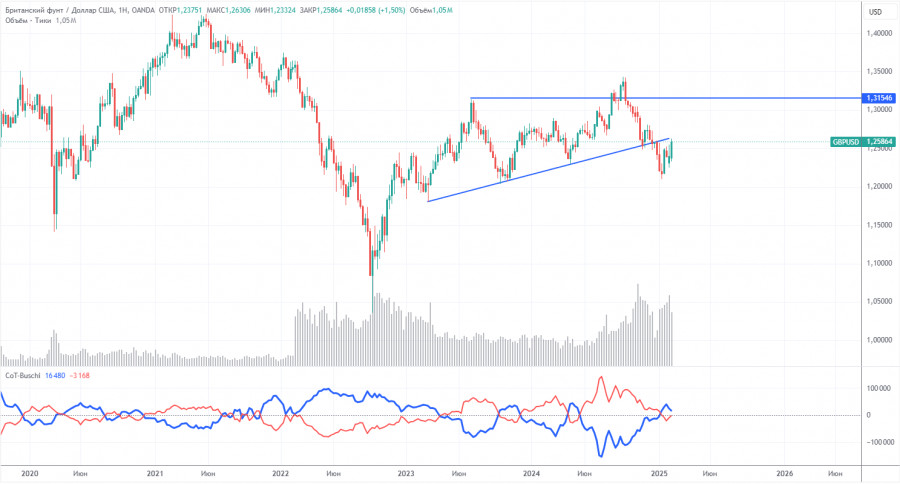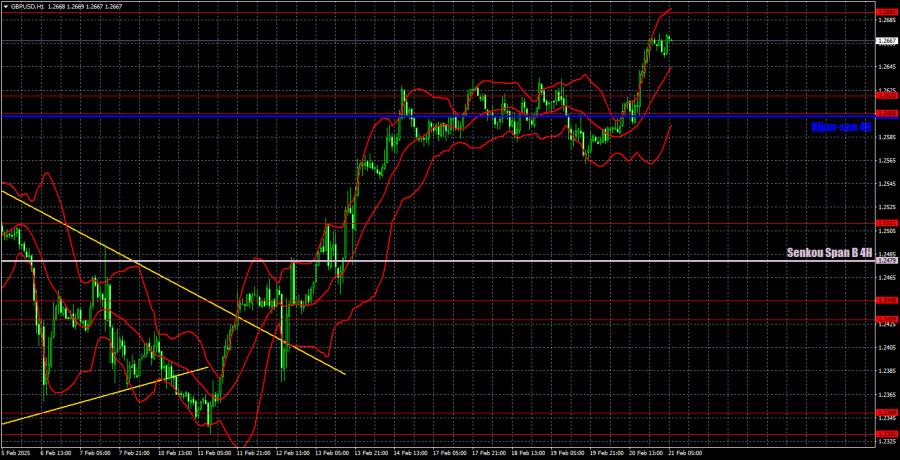

On Thursday, the GBP/USD currency pair initially remained stagnant but surged by nearly 100 pips. Such strong movements are rare, even after Bank of England or Federal Reserve meetings. However, yesterday, there were no significant events or reports in the UK, and the US only released two minor reports, which came after most of the upward movement had already occurred.
Earlier this week, traders ignored UK inflation and unemployment reports, just as they ignored US news last week, even though they were favorable for the US dollar. This suggests that recent price movements have little to do with macroeconomics or fundamentals. Instead, the pair is simply continuing a technical correction on the daily timeframe, which we have discussed for weeks. As a result, the price movements have been chaotic and difficult to predict.
Can the pound continue to rise? Yes, it can. The correlation between the pound and the euro is high, and the euro is currently trading more sideways than in an upward correction. We have highlighted the pound's higher resilience against the dollar for the past 1.5 years. The reason is that the European Central Bank might cut its key interest rate below 2% by the end of the year, while the Bank of England is taking a more measured approach to easing policy. Therefore, the pound is growing stronger than the euro, but falling weaker.
Yesterday, on the 5-minute timeframe, only one trading signal was generated. During the American trading session, the price broke through the area of 1.2605-1.2620, after which the pair rose by about 35 pips. While this movement was modest, it's important to note that the signal did not occur at the very beginning of the upward trend. After last week's increase of 200 pips, the price did not experience any downward correction, which would have provided more favorable entry points.

The Commitments of Traders (COT) reports for the British pound indicate that sentiment among commercial traders has been consistently shifting over the past few years. The red and blue lines, which represent the net positions of commercial and non-commercial traders, frequently intersect and generally remain close to the zero level. Currently, these lines are near each other, suggesting that the number of buy and sell positions is almost equal.
On the weekly timeframe, the price initially broke through the 1.3154 level before dropping to the trendline, which it subsequently breached. This break of the trendline strongly suggests that the pound's decline is likely to continue. However, there was also a rebound from the previous local low on the weekly timeframe, indicating that the currency pair may be experiencing a flat.
According to the latest COT report, the Non-commercial group opened 3,600 buy contracts and closed 4,500 sell contracts, resulting in an increase of 8,100 in net positions. However, this shift does not provide any substantial support for the pound.
The fundamental backdrop still does not justify long-term purchases of the pound, and the currency has a real chance of continuing its global downtrend. As such, net positions may continue to decline, signaling a potential further drop in demand for the British pound.

On the hourly timeframe, the GBP/USD pair continues its upward trend, showing very little signs of reversal. However, this may not be the final trend change we observe. Currently, we lack a clear explanation for the GBP's growth from a long-term perspective. On higher timeframes, we do not recommend taking long positions as the pound's position remains fundamentally unstable. The last couple of weeks have demonstrated that price movements are illogical, indicating that the pound's rise is primarily based on technical factors.
For February 21, we identify the following important levels: 1.2052, 1.2109, 1.2237–1.2255, 1.2331–1.2349, 1.2429–1.2445, 1.2511, 1.2605–1.2620, 1.2691–1.2701, and 1.2796–1.2816. Additionally, the Senkou Span B (1.2479) and Kijun-sen (1.2602) lines may provide valuable signals. It is recommended to set the Stop Loss level to breakeven once the price moves 20 pips in the favorable direction. Please keep in mind that the lines of the Ichimoku indicator may shift throughout the day, which should be considered when determining trading signals.
On Friday, the UK and the US are scheduled to publish business activity indices in the services and manufacturing sectors, but we would like to remind traders that the market has ignored a huge number of reports and events over the past two weeks, and the pair's movements occur far from the same time and days when the macroeconomic and fundamental background arrives.